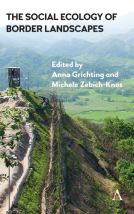The Social Ecology of Border Landscapes

This book applies an interdisciplinary lens to the study of border spaces, including their relationships with the built and natural environments. The section most relevant to urban areas is the alliterative Part III, on “Corridors: Catalysts and Collaboration in Confined Spaces”. The “Corridors” chapters explore a refugee camp in East Jerusalem; Belfast under a regime of regeneration; and legacies of conflict in Lebanon, including a refugee camp outside the city of Saida.
Ein el-Hilwi, in Lebanon, is a large, militarized refugee camp sometimes referred to as the “Capital of the Palestinian Diaspora”. Amidst the difficult living conditions, author Rabih Shibli focuses on an urban agriculture project undertaken by the Women’s Vocational Training Center in Ein el-Hilwi. The residents’ ingenuity is clear, as they have constructed a makeshift greenhouse on top of a corrugated metal roof festooned with satellite dishes. They have also built four underground reservoirs to collect rainwater. Shibli portrays these as attempts to reclaim space in a dense settlement largely devoid of greenery, as well as a symbolic reminder of Palestine that provides continuing hope.
Belfast, Northern Ireland represents the possibility of building back better following the cessation of conflict between Protestants and Catholics in 1998. Yet the spatial layout of the city makes it clear that ethno-religious divides persist in certain areas, accelerated by neoliberal rhythms of new development. Mixed parts of the city have become more prosperous and less sectarian, while poorer parts are more segregated. A vivid symbol of this bifurcation is the network of peace lines/interface structures (walls built to separate Protestants and Catholics), which mainly remain in the poorer north and west of the city. One line of thinking is that these areas need to be further securitized. Yet alternative visions have emerged of collaborative economies extending across sectarian and spatial lines, such as a social enterprise that built a childcare centre benefitting working mothers on both sides of an interface structure.
As these cases show, borders are symbolic as well as physical. The book’s chapters make clear the difficulties of forging community and participatory governance when an area is defined by separation. Yet they also offer encouraging examples of places that have rebounded from a history of division, such as the Pan-European Green Belt that has allowed for flourishing ecosystems in spaces formerly divided by the Iron Curtain. Ultimately, The Social Ecology of Border Landscapes demonstrates the need to examine border spaces not in isolation, which would reinforce marginalization, but as parts of a larger setting: political, economic, social and ecological.
Further reading:
Agnew, John (2008), “Borders on the mind: re-framing border thinking”, Ethics & Global Politics Vol 1, No 4, pages 175–191, available at https://www.tandfonline.com/doi/abs/10.3402/egp.v1i4.1892.
Environment and Urbanization (2004), “Urban violence and insecurity”, Vol 16, No 2, available at http://journals.sagepub.com/toc/eaua/16/2.
Environment and Urbanization (2014), “Conflict and violence in twenty-first century cities”, Vol 26, No 2, available at http://journals.sagepub.com/toc/eaua/26/2.
Book note prepared by Christine Ro
Search the Book notes database
Our Book notes database contains details and summaries of all the publications included in Book notes since 1993 - with details on how to obtain/download.
Use the search form above, or visit the Book notes landing page for more options and latest content.
For a searchable database for papers in Environment and Urbanization, go to http://eau.sagepub.com/

